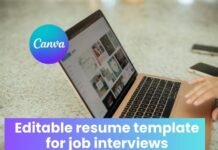The way we work has changed dramatically, and remote opportunities are now a mainstream part of the job market. From tech startups to Fortune 500 companies, employers are increasingly open to hiring candidates who can work effectively from anywhere in the world. This means that job seekers must rethink how they present themselves on paper. A generic, one-size-fits-all resume is no longer enough. Instead, you need a carefully designed resume template for remote work applications that demonstrates not only your professional skills but also your ability to thrive in a virtual workplace.
Remote roles place special emphasis on self-discipline, communication, and adaptability. Unlike traditional in-office jobs, recruiters want proof that you can manage tasks independently, collaborate across time zones, and stay productive without direct supervision. The design and structure of your resume template play a major role in conveying these qualities. A clean, ATS-friendly format combined with powerful content ensures that your application stands out in a competitive remote job market.
In this guide, we’ll walk through six proven steps for building a resume specifically tailored for remote positions. We’ll also break down the top soft and hard skills remote employers are prioritizing in 2025, along with strategies to highlight relevant experience—even if you’ve never officially worked remotely before. By the end, you’ll know exactly how to choose the right resume template, structure your content, and position yourself as the perfect remote-ready candidate.
5 Steps to Create a Remote Job Resume
When applying for a remote role, your resume needs to be more than a chronological record of your past positions. It must prove that you’re capable of excelling in a distributed work environment. A polished resume template for remote work applications should emphasize clarity, digital readiness, and skills that show you can thrive without in-person supervision. Let’s break down the five essential steps.
#1. Make It Known You’re Looking for a Remote Job
Recruiters often filter through hundreds of resumes, so you can’t afford to be vague about your career intentions. The first step is to clearly state that you’re targeting remote opportunities. This can be done in your resume header, summary, or even job title line. For example, instead of just writing “Project Manager, Chicago, IL”, you could write “Remote-Ready Project Manager | Open to Global Remote Roles”.
This small detail instantly signals to recruiters and applicant tracking systems (ATS) that you’re aligned with remote hiring needs. It also avoids any confusion about whether you’re seeking local, hybrid, or fully remote positions.
#2. Choose the Right Resume Template
Your resume template is your first impression—and for remote roles, digital presentation is everything. A modern, ATS-friendly design shows that you understand how online recruitment works.
The best resume template for remote work applications should include:
A clean, minimal layout with clear headings.
Readable fonts like Arial, Calibri, or Helvetica.
Consistent spacing and no distracting graphics.
Sections dedicated to skills, tools, and achievements.
A recruiter should be able to scan your resume within 6–8 seconds and understand your strengths. Using a simple yet professional template also ensures that automated hiring systems don’t misread your information, which can often happen with overly designed resumes.
#3. Write a Compelling Resume Summary
Your resume summary is the “hook” that captures attention right away. For remote applications, this short paragraph should not only highlight your career achievements but also demonstrate that you have the mindset and skills to work independently.
For example:
“Detail-oriented Content Strategist with 7+ years of experience leading distributed teams. Skilled in remote collaboration tools including Slack, Asana, and Google Workspace. Adept at managing international projects, balancing deadlines across time zones, and delivering creative campaigns that increase engagement by 40%.”
Notice how this doesn’t just list skills—it emphasizes adaptability, leadership in remote environments, and quantifiable results. That’s exactly what hiring managers want to see.
#4. Highlight Remote Working Skills
Employers hiring for remote positions are looking for more than technical qualifications. They need reassurance that you can handle the challenges of working away from an office. That’s why your resume should have a dedicated section for remote-friendly skills.
Instead of generic statements like “Strong communication skills”, showcase real-life examples such as:
“Facilitated weekly video conferences with cross-functional teams in North America and Europe, ensuring alignment despite a six-hour time difference.”
This demonstrates practical communication ability in a remote setting. Likewise, mentioning tools such as Zoom, Microsoft Teams, Notion, or Trello highlights your readiness to jump into a distributed workflow.
By aligning your skills with what remote employers value most, you give your resume the edge it needs to rise above the competition.
Remote Work Skills Employers Value
Remote employers look for candidates who bring not only technical expertise but also the personality traits and mindset required to succeed in a virtual environment. The right resume template for remote work applications should include a well-structured skills section where you highlight both soft and hard skills. In 2025, recruiters are paying even more attention to how well applicants balance interpersonal qualities with digital competence.

24 Top Soft Skills for Remote Workers in 2025
Soft skills form the backbone of remote work success. They determine how well you can collaborate with colleagues across time zones, handle challenges, and maintain productivity without constant supervision. Here are the most in-demand soft skills that should shine through your resume:
1. Communication – Clear writing and speaking are essential in remote setups where most interaction happens online.
2. Self-Motivation – Employers value workers who can stay productive without a manager physically present.
3. Adaptability – The ability to embrace new tools, workflows, or sudden project shifts.
4. Time Management – Remote teams rely on individuals who can meet deadlines consistently.
5. Problem-Solving – Quickly finding solutions when challenges arise without waiting for direct instructions.
6. Collaboration – Working with teams across borders and cultural differences.
7. Empathy – Building human connections through digital communication.
8. Conflict Resolution – Addressing misunderstandings constructively in a virtual environment.
9. Cultural Awareness – Respecting diverse work cultures across global teams.
10. Leadership – Guiding distributed teams and motivating others remotely.
Additional soft skills that are increasingly valued in 2025 include: reliability, accountability, creativity, emotional intelligence, critical thinking, resilience, organization, patience, proactivity, attention to detail, resourcefulness, flexibility, and fast learning.
When listing these on your resume, don’t just create a checklist—demonstrate them with action-oriented statements. For instance: “Organized remote brainstorming sessions with international teams, resulting in three new product ideas that increased revenue by 15%.” This shows soft skills in action rather than leaving them as empty buzzwords.
10 Top Hard Skills for Remote Workers in 2025
While soft skills establish your work ethic and adaptability, hard skills prove you can deliver results. In a digital-first hiring landscape, employers want assurance that you’re comfortable with technology and can operate independently in a remote setting.
The most important hard skills for remote resumes in 2025 include:
Project Management Tools – Proficiency in Asana, Jira, Trello, or Monday.com shows that you can keep projects on track virtually.
Video Conferencing Platforms – Mastery of Zoom, Google Meet, or Microsoft Teams is essential for remote communication.
Cloud Collaboration – Comfort with Google Workspace, Dropbox, or OneDrive ensures smooth file sharing and teamwork.
CRM Systems – Experience with Salesforce, HubSpot, or Zoho signals strong customer management skills.
Data Analysis – Ability to interpret and present data using Excel, Tableau, or Power BI.
Digital Marketing – SEO, PPC, email marketing, and content strategy are highly sought-after in remote hiring.
Cybersecurity Awareness – Understanding secure login practices, VPN use, and data protection in remote work.
Technical Troubleshooting – Solving common IT issues independently, which reduces downtime.
Automation Tools – Familiarity with Zapier, n8n, or Make to streamline repetitive tasks.
AI Productivity Tools – Using ChatGPT, Jasper, or other AI-powered platforms to speed up workflows.
Hard skills should always be backed up with evidence. Instead of simply listing “Data Analysis”, you might say: “Used Tableau to analyze marketing campaign performance, leading to a 22% improvement in ROI.” This demonstrates practical impact.
Structuring Work Experience for Remote Roles
#5. Create an Attention-Grabbing Work Experience Section
Your work experience section is one of the most powerful areas of your resume. For remote positions, it’s not enough to list job titles and responsibilities—you need to demonstrate that you can deliver results while working independently. Employers want proof that you can adapt to virtual collaboration, manage your time effectively, and achieve measurable outcomes.
Instead of writing vague descriptions, use achievement-based statements. For example:
“Led a remote team of 12 developers across three time zones, successfully launching a mobile app that reached 200,000 downloads in its first six months.”
“Increased customer retention by 18% while managing client relationships entirely online through HubSpot and Zoom.”
These examples highlight leadership, communication, and performance in a remote environment. They also use metrics—numbers that make your contributions concrete and impressive.
The design of your resume template for remote work applications should give prominence to this section. Use clear headings, consistent formatting, and bullet points where necessary to make each role easy to scan. Hiring managers should immediately see your value.
What If I Don’t Have Remote Work Experience?
A common concern for job seekers is: “What if I’ve never officially worked remotely?” The good news is that many employers don’t expect years of remote experience. What matters most is whether you can demonstrate transferable skills.
Think about times you’ve:
Collaborated with colleagues or clients in different cities or countries.
Used remote tools like Slack, Zoom, Trello, or Google Drive.
Worked on freelance or contract projects outside of a traditional office.
Managed your own schedule for independent projects or side hustles.
For example, even if you worked in an office, you could write:
“Coordinated weekly strategy calls with an overseas vendor team, ensuring smooth communication and timely delivery of projects.”
Or if you freelanced:
“Delivered content marketing projects for five international clients using online collaboration platforms, achieving an average 95% client satisfaction rate.”
These statements prove that you have the discipline, communication skills, and digital readiness to handle remote work—even if your previous roles weren’t 100% virtual.
Crafting the Perfect Complement
#6. Write a Persuasive Cover Letter
While your resume presents your professional history and skills, your cover letter gives you the opportunity to add personality, motivation, and context. For remote job applications, this step is just as important as choosing the right resume template for remote work applications. Employers want reassurance that you’re not only capable but also genuinely enthusiastic about working in a distributed environment.
A persuasive cover letter should:
Show motivation for remote work – Employers want to see that you’ve thought about why remote work suits you, whether it’s the flexibility, productivity, or ability to contribute to global teams.
Highlight independence and accountability – Hiring managers look for candidates who can manage themselves effectively without constant supervision.
Demonstrate technical readiness – Mention familiarity with remote collaboration tools, such as Slack, Zoom, Google Workspace, or project management software.
Express alignment with the company’s mission – Personalize your letter to show genuine interest in the role and organization, not just remote work in general.
Here’s a sample opening to inspire you:
“I am excited to apply for the Remote Marketing Specialist position at [Company Name]. Over the past five years, I’ve led global campaigns with distributed teams and consistently delivered measurable results. My experience with platforms like Asana, HubSpot, and Slack ensures that I can seamlessly integrate into your team’s digital workflow, while my strong time-management skills allow me to meet deadlines across multiple time zones.”
This type of introduction sets the tone by combining enthusiasm, practical skills, and evidence of success in a remote context.
In your closing paragraph, reiterate your excitement and encourage the employer to take the next step. For example:
“I look forward to the opportunity to contribute my expertise to [Company Name] while thriving in a remote-first environment. Thank you for considering my application. I would welcome the chance to discuss how my background aligns with your team’s goals.”
By aligning your resume and cover letter, you create a complete application package that demonstrates professionalism, remote readiness, and cultural fit.
Key Takeaways
In today’s evolving job market, remote opportunities are no longer a niche option—they’re a core part of how businesses operate in 2025. This shift means your application strategy must adapt as well. A traditional, generic resume may not capture the qualities that employers are specifically looking for in remote candidates. Instead, you need a carefully designed resume template for remote work applications that highlights your ability to succeed in a distributed environment.
Here are the most important points to remember:
Clarity is key – Make it obvious in your resume that you’re seeking remote opportunities. Employers don’t want to guess about your preferences.
Choose the right design – An ATS-friendly, minimalist template ensures your resume is both professional and easy to scan.
Lead with a strong summary – A compelling introduction positions you as remote-ready right away.
Emphasize remote skills – Highlight both soft skills (like adaptability, self-motivation, and communication) and hard skills (such as project management tools, video conferencing, and cloud collaboration).
Quantify your achievements – Use measurable results in your work experience section to stand out.
Show transferable experience – Even if you haven’t worked remotely before, demonstrate virtual collaboration or independent work examples.
Write a persuasive cover letter – Pair your resume with a letter that shows motivation, independence, and technical readiness.
When your resume and cover letter work together, you don’t just present yourself as a candidate—you position yourself as the perfect fit for the modern workforce.
Ultimately, the goal is simple: create a resume that doesn’t just list your qualifications but proves your readiness for the challenges and opportunities of remote work. With the right strategy and template, you can increase your chances of landing interviews and securing your ideal remote position.

